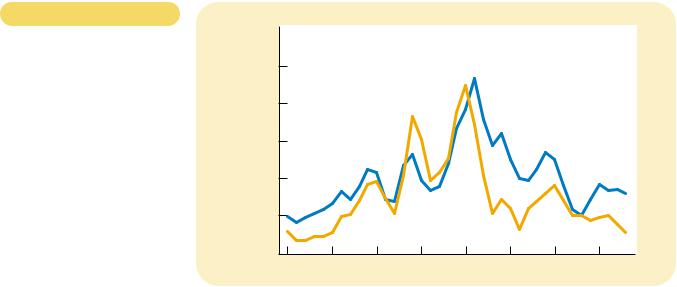
Mankiw. Principles Of Economics (2003)
.pdf

CHAPTER 16 MONEY GROWTH AND INFLATION |
353 |
QUICK QUIZ: The government of a country increases the growth rate of the money supply from 5 percent per year to 50 percent per year. What happens to prices? What happens to nominal interest rates? Why might the government be doing this?
THE COSTS OF INFLATION
In the late 1970s, when the U.S. inflation rate reached about 10 percent per year, inflation dominated debates over economic policy. And even though inflation was low during the 1990s, inflation remained a closely watched macroeconomic variable. One 1996 study found that inflation was the economic term mentioned most often in U.S. newspapers (far ahead of second-place finisher unemployment and third-place finisher productivity).
Inflation is closely watched and widely discussed because it is thought to be a serious economic problem. But is that true? And if so, why?
A FALL IN PURCHASING POWER? THE INFLATION FALLACY
If you ask the typical person why inflation is bad, he will tell you that the answer is obvious: Inflation robs him of the purchasing power of his hard-earned dollars. When prices rise, each dollar of income buys fewer goods and services. Thus, it might seem that inflation directly lowers living standards.
Yet further thought reveals a fallacy in this answer. When prices rise, buyers of goods and services pay more for what they buy. At the same time, however, sellers of goods and services get more for what they sell. Because most people earn their incomes by selling their services, such as their labor, inflation in incomes goes hand in hand with inflation in prices. Thus, inflation does not in itself reduce people’s real purchasing power.
People believe the inflation fallacy because they do not appreciate the principle of monetary neutrality. A worker who receives an annual raise of 10 percent tends to view that raise as a reward for her own talent and effort. When an inflation rate of 6 percent reduces the real value of that raise to only 4 percent, the worker might feel that she has been cheated of what is rightfully her due. In fact, as we discussed in Chapter 12, real incomes are determined by real variables, such as physical capital, human capital, natural resources, and the available production technology. Nominal incomes are determined by those factors and the overall price level. If the Fed were to lower the inflation rate from 6 percent to zero, our worker’s annual raise would fall from 10 percent to 4 percent. She might feel less robbed by inflation, but her real income would not rise more quickly.
If nominal incomes tend to keep pace with rising prices, why then is inflation a problem? It turns out that there is no single answer to this question. Instead, economists have identified several costs of inflation. Each of these costs shows some way in which persistent growth in the money supply does, in fact, have some effect on real variables.
354 PART SIX MONEY AND PRICES IN THE LONG RUN
SHOELEATHER COSTS
|
As we have discussed, inflation is like a tax on the holders of money. The tax itself |
|
is not a cost to society: It is only a transfer of resources from households to the gov- |
|
ernment. Yet, as we first saw in Chapter 8, most taxes give people an incentive to |
|
alter their behavior to avoid paying the tax, and this distortion of incentives causes |
|
deadweight losses for society as a whole. Like other taxes, the inflation tax also |
|
causes deadweight losses because people waste scarce resources trying to avoid it. |
|
How can a person avoid paying the inflation tax? Because inflation erodes the |
|
real value of the money in your wallet, you can avoid the inflation tax by holding |
|
less money. One way to do this is to go to the bank more often. For example, rather |
|
than withdrawing $200 every four weeks, you might withdraw $50 once a week. |
|
By making more frequent trips to the bank, you can keep more of your wealth in |
|
your interest-bearing savings account and less in your wallet, where inflation |
|
erodes its value. |
shoeleather costs |
The cost of reducing your money holdings is called the shoeleather cost of |
the resources wasted when inflation |
inflation because making more frequent trips to the bank causes your shoes to |
encourages people to reduce their |
wear out more quickly. Of course, this term is not to be taken literally: The actual |
money holdings |
cost of reducing your money holdings is not the wear and tear on your shoes but |
|
the time and convenience you must sacrifice to keep less money on hand than you |
|
would if there were no inflation. |
|
The shoeleather costs of inflation may seem trivial. And, in fact, they are in the |
|
U.S. economy, which has had only moderate inflation in recent years. But this cost |
|
is magnified in countries experiencing hyperinflation. Here is a description of one |
|
person’s experience in Bolivia during its hyperinflation (as reported in the August |
|
13, 1985, issue of The Wall Street Journal, p. 1): |
|
When Edgar Miranda gets his monthly teacher’s pay of 25 million pesos, he |
|
hasn’t a moment to lose. Every hour, pesos drop in value. So, while his wife |
|
rushes to market to lay in a month’s supply of rice and noodles, he is off with the |
|
rest of the pesos to change them into black-market dollars. |
|
Mr. Miranda is practicing the First Rule of Survival amid the most out-of- |
|
control inflation in the world today. Bolivia is a case study of how runaway |
|
inflation undermines a society. Price increases are so huge that the figures build |
|
up almost beyond comprehension. In one six-month period, for example, prices |
|
soared at an annual rate of 38,000 percent. By official count, however, last year’s |
|
inflation reached 2,000 percent, and this year’s is expected to hit 8,000 percent— |
|
though other estimates range many times higher. In any event, Bolivia’s rate |
|
dwarfs Israel’s 370 percent and Argentina’s 1,100 percent—two other cases of |
|
severe inflation. |
|
It is easier to comprehend what happens to the 38-year-old Mr. Miranda’s |
|
pay if he doesn’t quickly change it into dollars. The day he was paid 25 million |
|
pesos, a dollar cost 500,000 pesos. So he received $50. Just days later, with the rate |
|
at 900,000 pesos, he would have received $27. |
|
As this story shows, the shoeleather costs of inflation can be substantial. With the |
|
high inflation rate, Mr. Miranda does not have the luxury of holding the local |
|
money as a store of value. Instead, he is forced to convert his pesos quickly into |
|
goods or into U.S. dollars, which offer a more stable store of value. The time and |
|
effort that Mr. Miranda expends to reduce his money holdings are a waste of |

356 PART SIX MONEY AND PRICES IN THE LONG RUN
|
MENU COSTS |
|
Most firms do not change the prices of their products every day. Instead, firms of- |
|
ten announce prices and leave them unchanged for weeks, months, or even years. |
|
One survey found that the typical U.S. firm changes its prices about once a year. |
|
Firms change prices infrequently because there are costs of changing prices. |
menu costs |
Costs of price adjustment are called menu costs, a term derived from a restaurant’s |
the costs of changing prices |
cost of printing a new menu. Menu costs include the cost of deciding on new |
|
prices, the cost of printing new price lists and catalogs, the cost of sending these |
|
new price lists and catalogs to dealers and customers, the cost of advertising the |
|
new prices, and even the cost of dealing with customer annoyance over price |
|
changes. |
|
Inflation increases the menu costs that firms must bear. In the current U.S. |
|
economy, with its low inflation rate, annual price adjustment is an appropriate |
|
business strategy for many firms. But when high inflation makes firms’ costs rise |
|
rapidly, annual price adjustment is impractical. During hyperinflations, for exam- |
|
ple, firms must change their prices daily or even more often just to keep up with |
|
all the other prices in the economy. |
RELATIVE-PRICE VARIABILITY
AND THE MISALLOCATION OF RESOURCES
Suppose that the Eatabit Eatery prints a new menu with new prices every January and then leaves its prices unchanged for the rest of the year. If there is no inflation, Eatabit’s relative prices—the prices of its meals compared to other prices in the economy—would be constant over the course of the year. By contrast, if the inflation rate is 12 percent per year, Eatabit’s relative prices will automatically fall by 1 percent each month. The restaurant’s relative prices (that is, its prices compared with others in the economy) will be high in the early months of the year, just after it has printed a new menu, and low in the later months. And the higher the inflation rate, the greater is this automatic variability. Thus, because prices change only once in a while, inflation causes relative prices to vary more than they otherwise would.
Why does this matter? The reason is that market economies rely on relative prices to allocate scarce resources. Consumers decide what to buy by comparing the quality and prices of various goods and services. Through these decisions, they determine how the scarce factors of production are allocated among industries and firms. When inflation distorts relative prices, consumer decisions are distorted, and markets are less able to allocate resources to their best use.
INFLATION-INDUCED TAX DISTORTIONS
Almost all taxes distort incentives, cause people to alter their behavior, and lead to a less efficient allocation of the economy’s resources. Many taxes, however, become even more problematic in the presence of inflation. The reason is that lawmakers often fail to take inflation into account when writing the tax laws.

358 |
PART SIX MONEY AND PRICES IN THE LONG RUN |
The taxes on nominal capital gains and on nominal interest income are two examples of how the tax code interacts with inflation. There are many others. Because of these inflation-induced tax changes, higher inflation tends to discourage people from saving. Recall that the economy’s saving provides the resources for investment, which in turn is a key ingredient to long-run economic growth. Thus, when inflation raises the tax burden on saving, it tends to depress the economy’s long-run growth rate. There is, however, no consensus among economists about the size of this effect.
One solution to this problem, other than eliminating inflation, is to index the tax system. That is, the tax laws could be rewritten to take account of the effects of inflation. In the case of capital gains, for example, the tax code could adjust the purchase price using a price index and assess the tax only on the real gain. In the case of interest income, the government could tax only real interest income by excluding that portion of the interest income that merely compensates for inflation. To some extent, the tax laws have moved in the direction of indexation. For example, the income levels at which income tax rates change are adjusted automatically each year based on changes in the consumer price index. Yet many other aspects of the tax laws—such as the tax treatment of capital gains and interest income—are not indexed.
In an ideal world, the tax laws would be written so that inflation would not alter anyone’s real tax liability. In the world in which we live, however, tax laws are far from perfect. More complete indexation would probably be desirable, but it would further complicate a tax code that many people already consider too complex.
CONFUSION AND INCONVENIENCE
Imagine that we took a poll and asked people the following question: “This year the yard is 36 inches. How long do you think it should be next year?” Assuming we could get people to take us seriously, they would tell us that the yard should stay the same length—36 inches. Anything else would just complicate life needlessly.
What does this finding have to do with inflation? Recall that money, as the economy’s unit of account, is what we use to quote prices and record debts. In other words, money is the yardstick with which we measure economic transactions. The job of the Federal Reserve is a bit like the job of the Bureau of Stan- dards—to ensure the reliability of a commonly used unit of measurement. When the Fed increases the money supply and creates inflation, it erodes the real value of the unit of account.
It is difficult to judge the costs of the confusion and inconvenience that arise from inflation. Earlier we discussed how the tax code incorrectly measures real incomes in the presence of inflation. Similarly, accountants incorrectly measure firms’ earnings when prices are rising over time. Because inflation causes dollars at different times to have different real values, computing a firm’s profit—the difference between its revenue and costs—is more complicated in an economy with inflation. Therefore, to some extent, inflation makes investors less able to sort out successful from unsuccessful firms, which in turn impedes financial markets in their role of allocating the economy’s saving to alternative types of investment.

CHAPTER 16 MONEY GROWTH AND INFLATION |
359 |
A SPECIAL COST OF UNEXPECTED INFLATION:
ARBITRARY REDISTRIBUTIONS OF WEALTH
So far, the costs of inflation we have discussed occur even if inflation is steady and predictable. Inflation has an additional cost, however, when it comes as a surprise. Unexpected inflation redistributes wealth among the population in a way that has nothing to do with either merit or need. These redistributions occur because many loans in the economy are specified in terms of the unit of account—money.
Consider an example. Suppose that Sam Student takes out a $20,000 loan at a 7 percent interest rate from Bigbank to attend college. In ten years, the loan will come due. After his debt has compounded for ten years at 7 percent, Sam will owe Bigbank $40,000. The real value of this debt will depend on inflation over the decade. If Sam is lucky, the economy will have a hyperinflation. In this case, wages and prices will rise so high that Sam will be able to pay the $40,000 debt out of pocket change. By contrast, if the economy goes through a major deflation, then wages and prices will fall, and Sam will find the $40,000 debt a greater burden than he anticipated.
This example shows that unexpected changes in prices redistribute wealth among debtors and creditors. A hyperinflation enriches Sam at the expense of Bigbank because it diminishes the real value of the debt; Sam can repay the loan in less valuable dollars than he anticipated. Deflation enriches Bigbank at Sam’s expense because it increases the real value of the debt; in this case, Sam has to repay the loan in more valuable dollars than he anticipated. If inflation were predictable, then Bigbank and Sam could take inflation into account when setting the nominal interest rate. (Recall the Fisher effect.) But if inflation is hard to predict, it imposes risk on Sam and Bigbank that both would prefer to avoid.
This cost of unexpected inflation is important to consider together with another fact: Inflation is especially volatile and uncertain when the average rate of inflation is high. This is seen most simply by examining the experience of different countries. Countries with low average inflation, such as Germany in the late twentieth century, tend to have stable inflation. Countries with high average inflation, such as many countries in Latin America, tend also to have unstable inflation. There are no known examples of economies with high, stable inflation. This relationship between the level and volatility of inflation points to another cost of inflation. If a country pursues a high-inflation monetary policy, it will have to bear not only the costs of high expected inflation but also the arbitrary redistributions of wealth associated with unexpected inflation.
CASE STUDY THE WIZARD OF OZ
AND THE FREE-SILVER DEBATE
As a child, you probably saw the movie The Wizard of Oz, based on a children’s book written in 1900. The movie and book tell the story of a young girl, Dorothy, who finds herself lost in a strange land far from home. You probably did not know, however, that the story is actually an allegory about U.S. monetary policy in the late nineteenth century.
From 1880 to 1896, the price level in the U.S. economy fell by 23 percent. Because this event was unanticipated, it led to a major redistribution of

360 |
PART SIX MONEY AND PRICES IN THE LONG RUN |
wealth. Most farmers in the western part of the country were debtors. Their creditors were the bankers in the east. When the price level fell, it caused the real value of these debts to rise, which enriched the banks at the expense of the farmers.
According to populist politicians of the time, the solution to the farmers’ problem was the free coinage of silver. During this period, the United States was operating with a gold standard. The quantity of gold determined the money supply and, thereby, the price level. The free-silver advocates wanted silver, as well as gold, to be used as money. If adopted, this proposal would have increased the money supply, pushed up the price level, and reduced the real burden of the farmers’ debts.
The debate over silver was heated, and it was central to the politics of the 1890s. A common election slogan of the populists was “We Are Mortgaged. All But Our Votes.” One prominent advocate of free silver was William Jennings Bryan, the Democratic nominee for president in 1896. He is remembered in part for a speech at the Democratic party’s nominating convention in which he said, “You shall not press down upon the brow of labor this crown of thorns. You shall not crucify mankind upon a cross of gold.” Rarely since then have politicians waxed so poetic about alternative approaches to monetary policy. Nonetheless, Bryan lost the election to Republican William McKinley, and the United States remained on the gold standard.
L. Frank Baum, the author of the book The Wonderful Wizard of Oz, was a midwestern journalist. When he sat down to write a story for children, he made the characters represent protagonists in the major political battle of his time. Although modern commentators on the story differ somewhat in the interpretation they assign to each character, there is no doubt that the story highlights the debate over monetary policy. Here is how economic historian Hugh Rockoff, writing in the August 1990 issue of the Journal of Political Economy, interprets the story:
DOROTHY: Traditional American values
TOTO: Prohibitionist party, also called the
Teetotalers
SCARECROW: Farmers
TIN WOODSMAN: Industrial workers
COWARDLY LION: William Jennings Bryan
MUNCHKINS: Citizens of the east
WICKED WITCH OF THE EAST: Grover Cleveland
WICKED WITCH OF THE WEST: William McKinley
WIZARD: Marcus Alonzo Hanna, chairman of the
Republican party
OZ: Abbreviation for ounce of gold
YELLOW BRICK ROAD: Gold standard
In the end of Baum’s story, Dorothy does find her way home, but it is not by just following the yellow brick road. After a long and perilous journey, she learns that the wizard is incapable of helping her or her friends. Instead, Dorothy finally discovers the magical power of her silver slippers. (When the book was

CHAPTER 16 MONEY GROWTH AND INFLATION |
361 |
AN EARLY DEBATE OVER
MONETARY POLICY
made into a movie in 1939, Dorothy’s slippers were changed from silver to ruby. Apparently, the Hollywood filmmakers were not aware that they were telling a story about nineteenth-century monetary policy.)
Although the populists lost the debate over the free coinage of silver, they did eventually get the monetary expansion and inflation that they wanted. In 1898 prospectors discovered gold near the Klondike River in the Canadian Yukon. Increased supplies of gold also arrived from the mines of South Africa. As a result, the money supply and the price level started to rise in the United States and other countries operating on the gold standard. Within 15 years, prices in the United States were back to the levels that had prevailed in the 1880s, and farmers were better able to handle their debts.
QUICK QUIZ: List and describe six costs of inflation.
CONCLUSION
This chapter discussed the causes and costs of inflation. The primary cause of inflation is simply growth in the quantity of money. When the central bank creates money in large quantities, the value of money falls quickly. To maintain stable prices, the central bank must maintain strict control over the money supply.
The costs of inflation are more subtle. They include shoeleather costs, menu costs, increased variability of relative prices, unintended changes in tax liabilities, confusion and inconvenience, and arbitrary redistributions of wealth. Are these costs, in total, large or small? All economists agree that they become huge during hyperinflation. But their size for moderate inflation—when prices rise by less than 10 percent per year—is more open to debate.
Although this chapter presented many of the most important lessons about inflation, the discussion is incomplete. When the Fed reduces the rate of money growth, prices rise less rapidly, as the quantity theory suggests. Yet as the economy makes the transition to this lower inflation rate, the change in monetary policy will have disruptive effects on production and employment. That is, even though monetary policy is neutral in the long run, it has profound effects on real variables in
